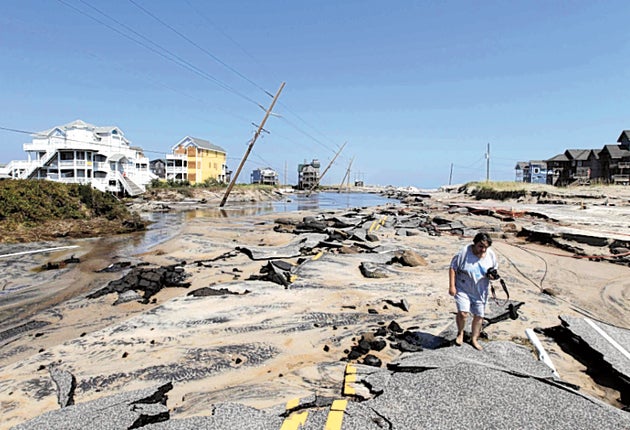Floods spread north as US counts cost of Irene

Your support helps us to tell the story
From reproductive rights to climate change to Big Tech, The Independent is on the ground when the story is developing. Whether it's investigating the financials of Elon Musk's pro-Trump PAC or producing our latest documentary, 'The A Word', which shines a light on the American women fighting for reproductive rights, we know how important it is to parse out the facts from the messaging.
At such a critical moment in US history, we need reporters on the ground. Your donation allows us to keep sending journalists to speak to both sides of the story.
The Independent is trusted by Americans across the entire political spectrum. And unlike many other quality news outlets, we choose not to lock Americans out of our reporting and analysis with paywalls. We believe quality journalism should be available to everyone, paid for by those who can afford it.
Your support makes all the difference.As commuters trickled into a mostly unscathed New York City yesterday in the wake of Hurricane Irene, raging rivers continued to cause record flooding all across the north-eastern United States and electricity companies struggled to restore power to 5m darkened homes and businesses.
Damaged and blocked rail lines more or less shut down morning commuter services from the suburbs to Manhattan, which had itself emerged mostly intact from the storm. Wall Street was open yesterday and the US Open Tennis Tournament began in Queens as planned. Some questioned whether the authorities had unnecessarily overstated the dangers associated with Irene in the hours before she struck.
The hurricane's legacy was nonetheless one of misery for many. At least 38 people died in the US before it crossed into eastern Canada. One man in a suburb north of New York City died trying to help a father and son entangled in live power lines. After being electrocuted himself he fell into a puddle of water that was also live, preventing horrified onlookers from pulling him away.
In New Jersey, Celena Sylvestri, 20, called police to say she was up to her neck in flood water in her car. When a rescue team found her eight hours later still at the wheel she had drowned.
Some of the heaviest rainfall was in the Catskill region of New York and in Vermont which last night was confronting its worst floods since 1927, with roads washed out and buildings partially destroyed, as well as one of Vermont's famous covered bridges in the town of Rockingham.
Vermont is not a place you would associate with a tropical storm. Yet floodwaters surged through Brattleboro, one of its biggest towns, and officials said the worst is still to come. "The bigger rivers haven't crested yet because the smaller brooks feed into them," Governor Peter Shumlin warned.
Counting the financial toll of Irene will take time, but Kinetic Analysis Corp, a consulting firm, tentatively put it at up to $7bn (£4.26bn) billion nationally, with insured losses of between $3bn and $4bn.
Some of the high price tag arose from measures ordered ahead of the storm that turned out not to have been necessary. In New York, Mayor Michael Bloomberg at one point ordered 370,000 residents to evacuate from low-lying areas.
"I would make the same decisions again without hesitation," the Mayor said when he was pressed to defend those early decisions. "We're just not going to take any risk with people's lives, and the best scenario possible is you take the precautions and it turns out they're not needed."
Rivers have days more to crest and bringing back a semblance of order to the region's mass transit networks may take as long. Airlines said they were forced to cancel no fewer than 12,000 flights since Saturday, a record for the industry. While hub airports were operating again yesterday, a backlog of hundreds of thousands of grounded passengers would take most of this week to clear.
Irene did leave some heroes in her wake. The actions of electrocuted man, David Reichenberg, spared the lives of both the father and son. But, lying in a puddle coursing with high-voltage current, he could not be saved.
"When emergency officials got there, they couldn't touch him. We were standing there for like five or 10 minutes. We were just praying, 'God help this man'," recalled one witness, Moishe Lichtenstein, 22.
Join our commenting forum
Join thought-provoking conversations, follow other Independent readers and see their replies
Comments